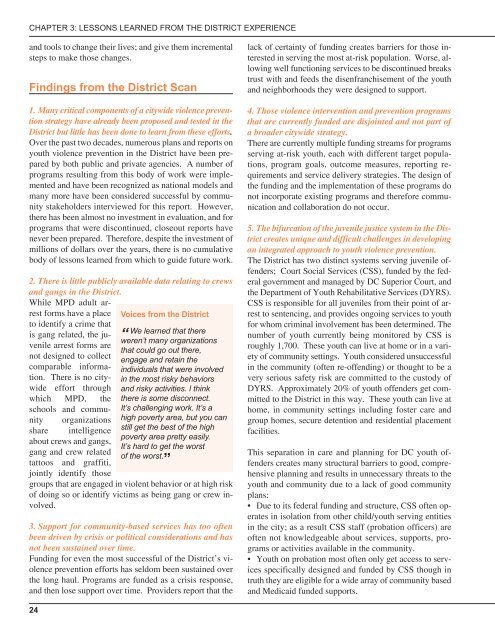Responding to Gang, Crew and Youth Violence in the District of Columbia
Responding to Gang, Crew and Youth Violence in the District of Columbia
Responding to Gang, Crew and Youth Violence in the District of Columbia
You also want an ePaper? Increase the reach of your titles
YUMPU automatically turns print PDFs into web optimized ePapers that Google loves.
CHAPTER 3: LESSONS LEARNED FROM THE DISTRICT EXPERIENCE<strong>and</strong> <strong>to</strong>ols <strong>to</strong> change <strong>the</strong>ir lives; <strong>and</strong> give <strong>the</strong>m <strong>in</strong>crementalsteps <strong>to</strong> make those changes.F<strong>in</strong>d<strong>in</strong>gs from <strong>the</strong> <strong>District</strong> Scan1. Many critical components <strong>of</strong> a citywide violence preventionstrategy have already been proposed <strong>and</strong> tested <strong>in</strong> <strong>the</strong><strong>District</strong> but little has been done <strong>to</strong> learn from <strong>the</strong>se efforts.Over <strong>the</strong> past two decades, numerous plans <strong>and</strong> reports onyouth violence prevention <strong>in</strong> <strong>the</strong> <strong>District</strong> have been preparedby both public <strong>and</strong> private agencies. A number <strong>of</strong>programs result<strong>in</strong>g from this body <strong>of</strong> work were implemented<strong>and</strong> have been recognized as national models <strong>and</strong>many more have been considered successful by communitystakeholders <strong>in</strong>terviewed for this report. However,<strong>the</strong>re has been almost no <strong>in</strong>vestment <strong>in</strong> evaluation, <strong>and</strong> forprograms that were discont<strong>in</strong>ued, closeout reports havenever been prepared. Therefore, despite <strong>the</strong> <strong>in</strong>vestment <strong>of</strong>millions <strong>of</strong> dollars over <strong>the</strong> years, <strong>the</strong>re is no cumulativebody <strong>of</strong> lessons learned from which <strong>to</strong> guide future work.2. There is little publicly available data relat<strong>in</strong>g <strong>to</strong> crews<strong>and</strong> gangs <strong>in</strong> <strong>the</strong> <strong>District</strong>.While MPD adult arrestforms have a place<strong>to</strong> identify a crime thatis gang related, <strong>the</strong> juvenilearrest forms arenot designed <strong>to</strong> collectcomparable <strong>in</strong>formation.There is no citywideeffort throughwhich MPD, <strong>the</strong>schools <strong>and</strong> communityorganizationsshare <strong>in</strong>telligenceabout crews <strong>and</strong> gangs,gang <strong>and</strong> crew relatedtat<strong>to</strong>os <strong>and</strong> graffiti,jo<strong>in</strong>tly identify thoseVoices from <strong>the</strong> <strong>District</strong>We learned that <strong>the</strong>re“weren’t many organizationsthat could go out <strong>the</strong>re,engage <strong>and</strong> reta<strong>in</strong> <strong>the</strong><strong>in</strong>dividuals that were <strong>in</strong>volved<strong>in</strong> <strong>the</strong> most risky behaviors<strong>and</strong> risky activities. I th<strong>in</strong>k<strong>the</strong>re is some disconnect.It’s challeng<strong>in</strong>g work. It’s ahigh poverty area, but you canstill get <strong>the</strong> best <strong>of</strong> <strong>the</strong> highpoverty area pretty easily.It’s hard <strong>to</strong> get <strong>the</strong> wors<strong>to</strong>f <strong>the</strong> worst.”groups that are engaged <strong>in</strong> violent behavior or at high risk<strong>of</strong> do<strong>in</strong>g so or identify victims as be<strong>in</strong>g gang or crew <strong>in</strong>volved.3. Support for community-based services has <strong>to</strong>o <strong>of</strong>tenbeen driven by crisis or political considerations <strong>and</strong> hasnot been susta<strong>in</strong>ed over time.Fund<strong>in</strong>g for even <strong>the</strong> most successful <strong>of</strong> <strong>the</strong> <strong>District</strong>’s violenceprevention efforts has seldom been susta<strong>in</strong>ed over<strong>the</strong> long haul. Programs are funded as a crisis response,<strong>and</strong> <strong>the</strong>n lose support over time. Providers report that <strong>the</strong>lack <strong>of</strong> certa<strong>in</strong>ty <strong>of</strong> fund<strong>in</strong>g creates barriers for those <strong>in</strong>terested<strong>in</strong> serv<strong>in</strong>g <strong>the</strong> most at-risk population. Worse, allow<strong>in</strong>gwell function<strong>in</strong>g services <strong>to</strong> be discont<strong>in</strong>ued breakstrust with <strong>and</strong> feeds <strong>the</strong> disenfranchisement <strong>of</strong> <strong>the</strong> youth<strong>and</strong> neighborhoods <strong>the</strong>y were designed <strong>to</strong> support.4. Those violence <strong>in</strong>tervention <strong>and</strong> prevention programsthat are currently funded are disjo<strong>in</strong>ted <strong>and</strong> not part <strong>of</strong>a broader citywide strategy.There are currently multiple fund<strong>in</strong>g streams for programsserv<strong>in</strong>g at-risk youth, each with different target populations,program goals, outcome measures, report<strong>in</strong>g requirements<strong>and</strong> service delivery strategies. The design <strong>of</strong><strong>the</strong> fund<strong>in</strong>g <strong>and</strong> <strong>the</strong> implementation <strong>of</strong> <strong>the</strong>se programs donot <strong>in</strong>corporate exist<strong>in</strong>g programs <strong>and</strong> <strong>the</strong>refore communication<strong>and</strong> collaboration do not occur.5. The bifurcation <strong>of</strong> <strong>the</strong> juvenile justice system <strong>in</strong> <strong>the</strong> <strong>District</strong>creates unique <strong>and</strong> difficult challenges <strong>in</strong> develop<strong>in</strong>gan <strong>in</strong>tegrated approach <strong>to</strong> youth violence prevention.The <strong>District</strong> has two dist<strong>in</strong>ct systems serv<strong>in</strong>g juvenile <strong>of</strong>fenders;Court Social Services (CSS), funded by <strong>the</strong> federalgovernment <strong>and</strong> managed by DC Superior Court, <strong>and</strong><strong>the</strong> Department <strong>of</strong> <strong>Youth</strong> Rehabilitative Services (DYRS).CSS is responsible for all juveniles from <strong>the</strong>ir po<strong>in</strong>t <strong>of</strong> arrest<strong>to</strong> sentenc<strong>in</strong>g, <strong>and</strong> provides ongo<strong>in</strong>g services <strong>to</strong> youthfor whom crim<strong>in</strong>al <strong>in</strong>volvement has been determ<strong>in</strong>ed. Thenumber <strong>of</strong> youth currently be<strong>in</strong>g moni<strong>to</strong>red by CSS isroughly 1,700. These youth can live at home or <strong>in</strong> a variety<strong>of</strong> community sett<strong>in</strong>gs. <strong>Youth</strong> considered unsuccessful<strong>in</strong> <strong>the</strong> community (<strong>of</strong>ten re-<strong>of</strong>fend<strong>in</strong>g) or thought <strong>to</strong> be avery serious safety risk are committed <strong>to</strong> <strong>the</strong> cus<strong>to</strong>dy <strong>of</strong>DYRS. Approximately 20% <strong>of</strong> youth <strong>of</strong>fenders get committed<strong>to</strong> <strong>the</strong> <strong>District</strong> <strong>in</strong> this way. These youth can live athome, <strong>in</strong> community sett<strong>in</strong>gs <strong>in</strong>clud<strong>in</strong>g foster care <strong>and</strong>group homes, secure detention <strong>and</strong> residential placementfacilities.This separation <strong>in</strong> care <strong>and</strong> plann<strong>in</strong>g for DC youth <strong>of</strong>fenderscreates many structural barriers <strong>to</strong> good, comprehensiveplann<strong>in</strong>g <strong>and</strong> results <strong>in</strong> unnecessary threats <strong>to</strong> <strong>the</strong>youth <strong>and</strong> community due <strong>to</strong> a lack <strong>of</strong> good communityplans:• Due <strong>to</strong> its federal fund<strong>in</strong>g <strong>and</strong> structure, CSS <strong>of</strong>ten operates<strong>in</strong> isolation from o<strong>the</strong>r child/youth serv<strong>in</strong>g entities<strong>in</strong> <strong>the</strong> city; as a result CSS staff (probation <strong>of</strong>ficers) are<strong>of</strong>ten not knowledgeable about services, supports, programsor activities available <strong>in</strong> <strong>the</strong> community.• <strong>Youth</strong> on probation most <strong>of</strong>ten only get access <strong>to</strong> servicesspecifically designed <strong>and</strong> funded by CSS though <strong>in</strong>truth <strong>the</strong>y are eligible for a wide array <strong>of</strong> community based<strong>and</strong> Medicaid funded supports.24


